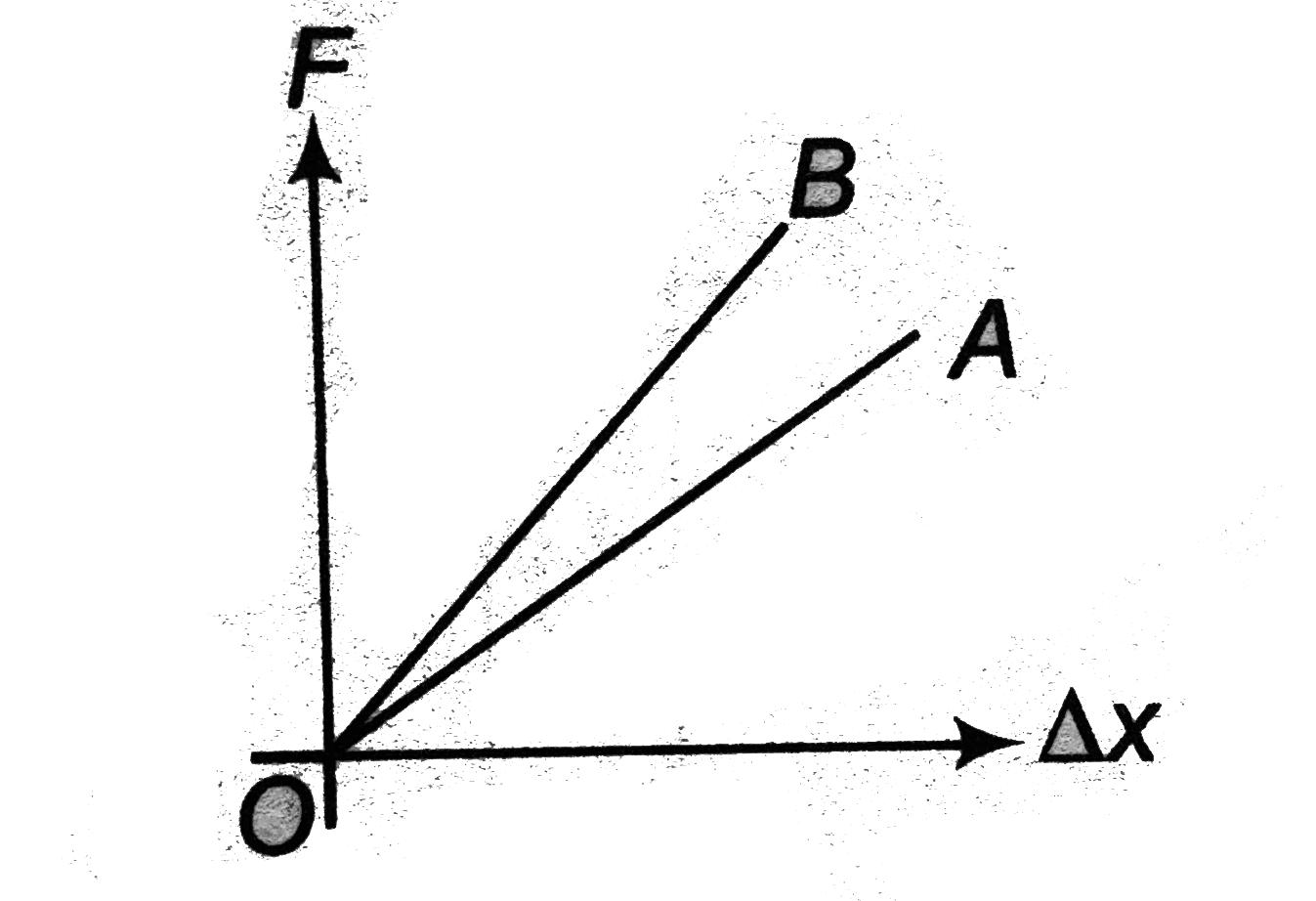Two wires P and Q are equally thick and made of the same material but the length of Pis twice that of Q
(a) Which wire will have a greater extension for a given load ?
(b) Which one will undergo a greater strain ?
To solve the problem step by step, we will analyze the two wires P and Q based on the information given.
Step 1: Understand the properties of the wires
- Both wires P and Q are equally thick, meaning they have the same cross-sectional area (A).
- Both wires are made of the same material, which implies they have the same Young's modulus (Y).
- The length of wire P (L_P) is twice that of wire Q (L_Q), i.e., L_P = 2L_Q.
Step 2: Apply the formula for extension
The extension (ΔL) in a wire under a load can be expressed using the formula:
ΔL=F⋅LA⋅Y
Where:
- ΔL = extension
- F = applied force (load)
- L = original length of the wire
- A = cross-sectional area
- Y = Young's modulus of the material
Step 3: Calculate the extension for both wires
For wire P:
ΔLP=F⋅LPA⋅Y=F⋅(2LQ)A⋅Y=2⋅F⋅LQA⋅Y=2ΔLQ
For wire Q:
ΔLQ=F⋅LQA⋅Y
Step 4: Compare the extensions
From the calculations:
ΔLP=2ΔLQ
This shows that wire P will have a greater extension than wire Q for the same applied load.
Step 5: Analyze strain in both wires
Strain (ε) is defined as the ratio of extension to the original length:
Strain=ΔLL
For wire P:
StrainP=ΔLPLP=2ΔLQ2LQ=ΔLQLQ
For wire Q:
StrainQ=ΔLQLQ
Step 6: Compare the strains
From the calculations:
StrainP=StrainQ
This indicates that both wires will undergo the same strain.
Final Answers
(a) Wire P will have a greater extension for a given load.
(b) Both wires will undergo the same strain.
---
- Both wires P and Q are equally thick, meaning they have the same cross-sectional area (A).
- Both wires are made of the same material, which implies they have the same Young's modulus (Y).
- The length of wire P (L_P) is twice that of wire Q (L_Q), i.e., L_P = 2L_Q.
The extension (ΔL) in a wire under a load can be expressed using the formula:
ΔL=F⋅LA⋅Y
Where:
- ΔL = extension
- F = applied force (load)
- L = original length of the wire
- A = cross-sectional area
- Y = Young's modulus of the material
For wire P:
ΔLP=F⋅LPA⋅Y=F⋅(2LQ)A⋅Y=2⋅F⋅LQA⋅Y=2ΔLQ
For wire Q:
ΔLQ=F⋅LQA⋅Y
From the calculations:
ΔLP=2ΔLQ
This shows that wire P will have a greater extension than wire Q for the same applied load.
Strain (ε) is defined as the ratio of extension to the original length:
Strain=ΔLL
For wire P:
StrainP=ΔLPLP=2ΔLQ2LQ=ΔLQLQ
For wire Q:
StrainQ=ΔLQLQ
From the calculations:
StrainP=StrainQ
This indicates that both wires will undergo the same strain.
(a) Wire P will have a greater extension for a given load.
(b) Both wires will undergo the same strain.
Topper's Solved these Questions
- SELF ASSESSMENT PAPER 01BOOK - ICSECHAPTER - SELF ASSESSMENT PAPER 01EXERCISE - SECTION - C (Answer the following )
9 Videos
- SELF ASSESSMENT PAPER 01BOOK - ICSECHAPTER - SELF ASSESSMENT PAPER 01EXERCISE - SECION- D (Answer the following )
6 Videos
- SELF ASSESSMENT PAPER 01BOOK - ICSECHAPTER - SELF ASSESSMENT PAPER 01EXERCISE - SECTION-A (Answer the following)
7 Videos
- SAMPLE QUESTION PAPER-3 BOOK - ICSECHAPTER - SAMPLE QUESTION PAPER-3 EXERCISE - SECTION-D
6 Videos
- SELF ASSESSMENT PAPER 02BOOK - ICSECHAPTER - SELF ASSESSMENT PAPER 02EXERCISE - SECTION-D (Answer the following )
6 Videos
Similar Questions
Two wires A and B have equal lengths and aremade of the same material , but diameter of wire A is twice that of wire B. Then, for a given load,
View SolutionTwo wires A and B have the same cross section and are made of the same material, but the length of wire A is twice that of B. Then, for a given load
View Solution
Knowledge Check
The following four wires are made of the same material which of these will have the largest extension when the same tension is applied
AÂ L=100 cm, r- 0.2 mmBÂ L=200 cm, r 0.4 mmCÂ L 300 cm, r 0.6 mmDL 400 cm, r 0.8 mm
Two copper wires are of the same length, but one is thicker than the other :
(a) Which wire will have more resistance?
(b) Which wire will have more specific resistance?
View SolutionTwo wires A and B of same dimensions are stretched by same amount of force .Young's modulus of A is twice that of B. Which wire will get more elongation?
View SolutionTwo copper wires are of the same length, but one is thicker than the other.
(1) Which wire will have more resistance ?
(2) Which wire will have more specific resistance ?
View SolutionTwo wires are together end to end . The wires are made of the same material , but the diameter of one is twice that of the other . They are subjected to a tension of 4.60N. The thin wire has a length of 40.0cm and a linear mass density of 2.00g/m. The combination is fixed at both ends and vibrated in such a way that two antinodes are present , with the node between them being precisely at the weld . (a) What is the frequency of vibration ? (b) Find the length of the thick wire .
View SolutionTwo wires A and B of same length are made of same material . The figure represents the load F versus extension Δx graph for the wires. Then

View SolutionTwo wires of equal length are stretched by the same force. One wire is heavy while the other is light which one will have less frequency
View SolutionTwo wires of same diameter of the same material having the length l and 2l If the force F is applied on each, the ratio of the work done in two wires will be
View Solution
